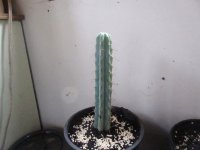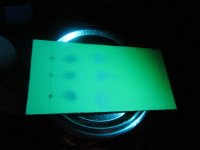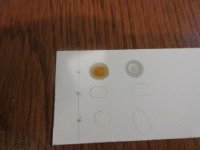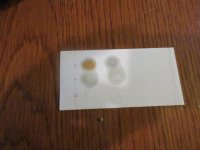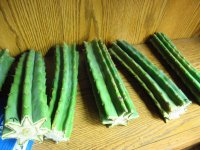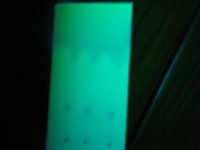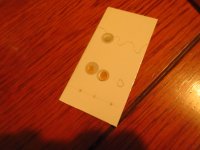urtica
Rising Star
I am so excited to get ahold of these TLC kits for research purposes.
I have been growing a number of Trichocereus species for many years, with the intention of doing some chemical analysis someday.
I also would love to figure out why it is the Trichocereus bridgesii is subjectively so much 'speedier' than Trichocereus pachanoi or peruvianus (in my and many other people's experience).
I hope that I will do this same process with a number of different Trichocereus species & clones over the next year or so.
OK.
Starting Material was 1025 g fresh Trichocereus bridgesii, a clone that I will call 'Kate'. Picture enclosed. Is was about 3 feet of skinny cactus. I also put 410g of the fresh material in a food dehydrator to dry.
The alkaloidal fraction was obtained using Kash's A/B tek, which can be found on the Wiki.
At the end of the extraction I was left with 633 mg of tannish powder. (o.633 g)
I tested this powder (about 5 mg) using Marquis reagent, and the color change (orange) indicated the presence of mescaline.
I then ran TLC on the alkaloid, again using ~5 mg, using the Bunk Police kit & following the enclosed directions.
I ended up with one nice clear spot and a streaky spot above that. Both flouresced under black light.
I have not yet run caffeine next to the alkaloid to compare RF values but maybe that will even happen today.
The spot reacted with the Marquis reagent in the same way that the original alkaloid did, while the streak had no reaction. Neither reacted to Ehrlich. (Picture enclosed)
I am led to believe that the streak is some residual plant goo as it did not react to the Marquis and I only washed the crystals once with cold MEK, not doing the final purification step that Kash outlines.
When the cactus came out of the food dehydrator it weighed 21g. This indicates that 95% of the fresh weight of this cactus was water (a little different than the 90% water weight that I usually hear).
So, my fresh cactus material had 0.06% alkaloid, if dried it would have contained 1.2% alkaloid.
Not bad!
Now where does the stimulation come from? I only see one spot so it must not be an alkaloid, although I am hoping to get GC/MS analysis done to see if that spot is actually composed of multiple alkaloids.
POSTSCRIPT 02/16 I bioassayed 300 mg of this extract and it was beautiful, so nice. It felt about as speedy to me as taking T bridgesii in whole form, so maybe there are not extra alkaloids? Or maybe the MAOI type constituent is not an alkaloid, but is still present in my second plant goo spot? The isolated alkaloid did seem, to me, to be lacking some of the magic of the whole plant, but it was still so beautiful & fun & fucking exhausting actually.
I have been growing a number of Trichocereus species for many years, with the intention of doing some chemical analysis someday.
I also would love to figure out why it is the Trichocereus bridgesii is subjectively so much 'speedier' than Trichocereus pachanoi or peruvianus (in my and many other people's experience).
I hope that I will do this same process with a number of different Trichocereus species & clones over the next year or so.
OK.
Starting Material was 1025 g fresh Trichocereus bridgesii, a clone that I will call 'Kate'. Picture enclosed. Is was about 3 feet of skinny cactus. I also put 410g of the fresh material in a food dehydrator to dry.
The alkaloidal fraction was obtained using Kash's A/B tek, which can be found on the Wiki.
At the end of the extraction I was left with 633 mg of tannish powder. (o.633 g)
I tested this powder (about 5 mg) using Marquis reagent, and the color change (orange) indicated the presence of mescaline.
I then ran TLC on the alkaloid, again using ~5 mg, using the Bunk Police kit & following the enclosed directions.
I ended up with one nice clear spot and a streaky spot above that. Both flouresced under black light.
I have not yet run caffeine next to the alkaloid to compare RF values but maybe that will even happen today.
The spot reacted with the Marquis reagent in the same way that the original alkaloid did, while the streak had no reaction. Neither reacted to Ehrlich. (Picture enclosed)
I am led to believe that the streak is some residual plant goo as it did not react to the Marquis and I only washed the crystals once with cold MEK, not doing the final purification step that Kash outlines.
When the cactus came out of the food dehydrator it weighed 21g. This indicates that 95% of the fresh weight of this cactus was water (a little different than the 90% water weight that I usually hear).
So, my fresh cactus material had 0.06% alkaloid, if dried it would have contained 1.2% alkaloid.
Not bad!
Now where does the stimulation come from? I only see one spot so it must not be an alkaloid, although I am hoping to get GC/MS analysis done to see if that spot is actually composed of multiple alkaloids.
POSTSCRIPT 02/16 I bioassayed 300 mg of this extract and it was beautiful, so nice. It felt about as speedy to me as taking T bridgesii in whole form, so maybe there are not extra alkaloids? Or maybe the MAOI type constituent is not an alkaloid, but is still present in my second plant goo spot? The isolated alkaloid did seem, to me, to be lacking some of the magic of the whole plant, but it was still so beautiful & fun & fucking exhausting actually.

